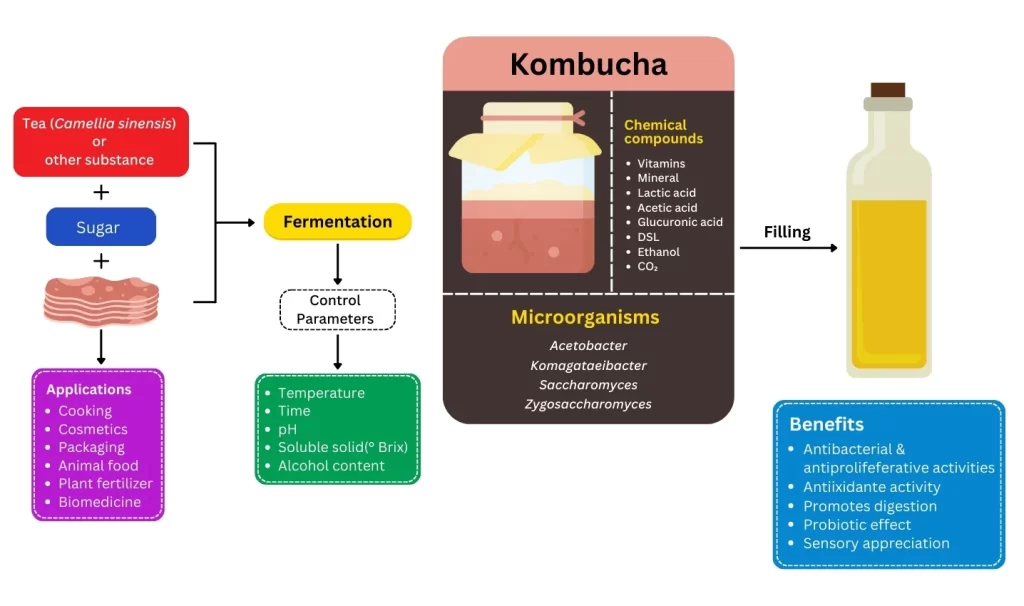Kombucha: Fermented Drink Formulation
Interesting News, August 12, 2024.

Kombucha: Fermented Drink Formulation

Start your beverage
brand today

To review your food with Professional
staying one Step ahead
Share
Fermentation, one of the oldest and most energy-efficient food preservation methods, has long played a vital role in ensuring food safety and extending shelf life. Science has revealed that during fermentation, various biochemical transformations occur, significantly altering the nutrient content and enhancing the bioactivity and digestibility of the final product. In recent years, scientific advancements have increasingly harnessed this process in the food and beverage industries to optimize the production and extraction of bioactive compounds from plants, showcasing the potential of fermentation in modern food science.
Fermented tea is believed to have first been used for its therapeutic benefits in East Asia around 220 BC. It is thought to have originated in northeastern China, specifically in Manchuria, where it was embraced during the Tsin Dynasty for its detoxifying and energizing properties. The term “Kombucha” or “Kombu tea” is said to come from a Japanese legend dating back to 414 CE. According to the story, a physician named Kombu brought the tea to Japan and successfully treated Emperor Inkyo’s digestive problems, which led to the tea being named in his honor.
Kombucha is a fizzy drink/beverage with a sweet-tart taste, reminiscent of cider. As a living product, much like fruits and vegetables, it is rich in enzymes that aid digestion. Moreover, kombucha supports the body’s natural defenses, enhancing overall resilience. The global kombucha market has experienced substantial growth in recent years, reaching USD 1.84 billion in 2019. It is expected to continue expanding at a projected growth rate of 23.2% by 2027. There are numerous kombucha brands available on the market today, including GT’s Living Foods, Wonder Drink, Humm Kombucha, KÖE, Rowdy Mermaid, Kevita Master Brew, Brew Dr., Clearly Kombucha, Health-Ade, Aqua ViTea, Dominga, Gutsy, Hoochy Booch, Vitae, The GUTsy Captain, SynerChi, Holo, Leave Your Sword, Equinox, Biona, MOJO, Remedy, Naughty Booch, Swig, BomBooch, and Wild Kombucha. The wide variety of brands reflects the growing popularity of kombucha, largely driven by its therapeutic benefits.
What is Kombucha: Its Process
Kombucha tea, a fermented beverage is made from a symbiotic culture of acetic acid bacteria (such as Komagataeibacter, Gluconobacter, and Acetobacter species), lactic acid bacteria (like Lactobacillus and Lactococcus), and various yeasts, including Schizosaccharomyces pombe, Saccharomyces cerevisiae, and Brettanomyces bruxellensis, among others. The fermentation occurs in a sweetened medium, typically black tea, using either a previously fermented tea broth (10–20% v/v) or a tea fungus pellicle. The mixture is then incubated under static aerobic conditions for 7 to 14 days at temperatures ranging from 20°C to 30°C. This leads to the formation of a floating biofilm on the surface of the liquid due to the activity of certain bacterial strains.
Kombucha is typically made by fermenting sweetened black or green tea or white tea. The primary acids produced during this process—acetic, gluconic, tartaric, malic, and citric—contribute to Kombucha’s distinct sour flavor. With the growing consumer demand for minimally processed foods that are additive-free and offer high nutritional value and health benefits, traditional Kombucha tea has gained significant attention for its probiotic properties.
Substrates used to obtain Kombucha
Kombucha is traditionally prepared using black and green teas, both of which are derived from the leaves of the Camellia sinensis plant. The primary distinction between these two teas lies in the processing methods applied to the leaves. Black tea is produced by crushing the leaves and allowing them to undergo oxidation in a high-humidity environment. This process is driven by the enzyme polyphenol oxidase, which leads to the oxidation of the polyphenols, giving black tea its characteristic color and flavor. For the home fermentation process is considered complete once the desired level of sourness is reached. In experimental or industrial settings, however, the endpoint is typically determined by measuring key parameters such as pH, total titratable acidity (TTA), alcohol content, and sugar concentration. For optimal flavor, kombucha should ideally have a pH between 2.5 and 3.5, while a TTA of approximately 4 g/L is recognized for producing a traditional kombucha with high sensory appeal.

Symbiotic Culture of Bacteria and Yeast (SCOBY)
Kombucha’s culture, known as the Symbiotic Culture of Bacteria and Yeast (SCOBY), is a biofilm created from the symbiotic relationship between specific yeasts and acetic acid bacteria. Often referred to as “fungus tea” due to its appearance resembling a fungal mat when grown in a static environment, this biofilm develops in sweetened, cooled tea, forming a cellulose-based film. SCOBY is the cellulosic layer that forms on the surface of the tea. Its primary function is to facilitate the fermentation process, transforming the tea into the characteristic kombucha beverage.
Microbiological Composition of Kombucha
The microbiological composition of kombucha primarily consists of acetic acid bacteria and osmophilic yeasts, as noted by De Filippis et al. (2018). However, this composition is not strictly defined and can vary depending on factors such as the origin of the culture, the substrates used, and the specific production conditions.
Benefits
Kombucha, a fermented beverage with roots in Asia, has become increasingly popular in the West due to its numerous therapeutic benefits. These include antimicrobial, antioxidant, anticarcinogenic, and antidiabetic properties, as well as its effectiveness in treating gastric ulcers and high cholesterol and blood pressure, inhibit cancer progression, and enhance liver function, immune response, and gastrointestinal health. Additionally, Kombucha has been found to positively influence the immune system and support liver detoxification. This growing interest in kombucha has coincided with increased scientific research into the impact of the microbiome on overall health.
Innovation in the formulation of Kombucha
There are several innovations happening in the formulation of kombucha such as an infusion of specialty Arabic coffee from the first fermentation, kombucha tea with noni fruit extract, mulberry coproducts generated as agro-industrial waste during mulberry production, microencapsulated kombucha fermentation starter culture, specifically komagataeibacter saccharivorans, Levilactobacillus brevis and Saccharomyces cerevisiae, through spray-drying and freeze-drying and many more.
Legislation
In the United States, fermented beverages and acidified canned foods are generally exempt from FDA regulation, which means there is no specific legislation governing kombucha (Nummer, 2013). However, kombucha is classified as a fermented beverage produced through a “specialized process,” and producers are required to present a Hazard Analysis and Critical Control Point (HACCP) plan to ensure its safe production (FDA, 2009). To further manage the production process and ensure consumer safety, the Pennsylvania Department of Agriculture has issued guidelines to assist producers in meeting these safety standards.
At FRL, we provide comprehensive support for kombucha formulation utilizing alternative and innovative substrates at the commercial industry level, ensuring legal compliance, nutritional accuracy, and optimal product quality.

Let’s create something Innovative and Delicious together
Food Research Lab strives for excellence in new Food, Beverage and Nutraceutical Product Research and Development by offering cutting edge scientific analysis and expertise.





